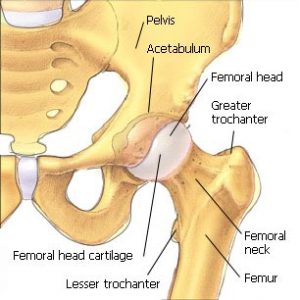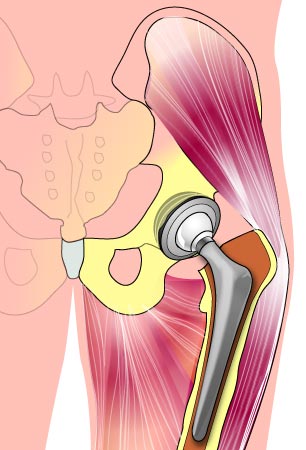Total Hip Replacement Surgery
The simple pleasures of life can often be taken away by a stiff, painful hip. In some cases, a problem hip may make even the simplest movements a painful experience.
Thanks to medical and technical advances, your orthopedic surgeon can often relieve much of this pain and discomfort with a total hip replacement. Total hip replacements are a reliable and safe surgical means of improving the overall function of the hip.
Problem hips usually have a tendency to worsen as time goes bye. Activities such as walking, getting up from a chair, or sex can become extremely painful experiences. Eventually, pain and stiffness may prevent you from enjoying many of your normal, daily activities. Putting on socks and shoes becomes difficult or impossible and the sufferer’s independence is lost. He becomes dependent on the help of others.
Hip disease can result from a variety of causes.
Osteoarthritis, which occurs when the cartilage in the hip joint begins to break down, is the most common cause of hip pain and disability. When the cartilage begins to break down, the hip bones begin to wear against each other – resulting in pain and limitation of movement. Rheumatoid arthritis, injuries, developmental faults, and loss of blood supply are also frequent causes of a painful problem hip.
Sometimes a hip replacement operation, which was done some years in the past, begins to give pain. This may be due to the loosening of the implants or rarely to an infection. A repeat operation may become necessary for pain and restricted function,or for loss of bone substance: this is called Revision Total Hip Arthroplasty. For details see the section devoted to this subject in “Hip Joint Surgery Technologies”.
Your Hip Joints
The hip is a ball-and-socket joint. The hip joint is formed by the femur (large upper leg bone) which rotates in the acetabulum (socket portion of the joint in the pelvis). The hip joint is surrounded by ligaments, and muscles. Smooth cartilage covers the ends of the bones and allows for easy, painless movement in the hip socket.

The Artificial Hip
The technology is available to replace a problem hip and return you to an active life. An artificial hip joint (prosthesis) is made up of a ball and socket which fit together to form a joint very similar to your own hip. Following a thorough diagnosis of your hip problem, your orthopedic surgeon will select the prosthesis best suited to your situation.
Osteotomy
Sometimes it is possible to improve your hip by repositioning the bones, thereby improving the biomechanics. This may be particularly suitable in young people who have defective hips from birth.
Hip Problems
Most serious hip problems occur when the cushioning smooth cartilage of the joint begins to wear down. The hip bones will eventually start to rub against each other. As the joint continues to deteriorate, bone growths (often called “spurs”) may begin to form around the ends of the bone. Eventually, the bones become deformed and irregular. Walking, and even small movements, will create friction between the ball and socket of the hip, resulting in pain.
